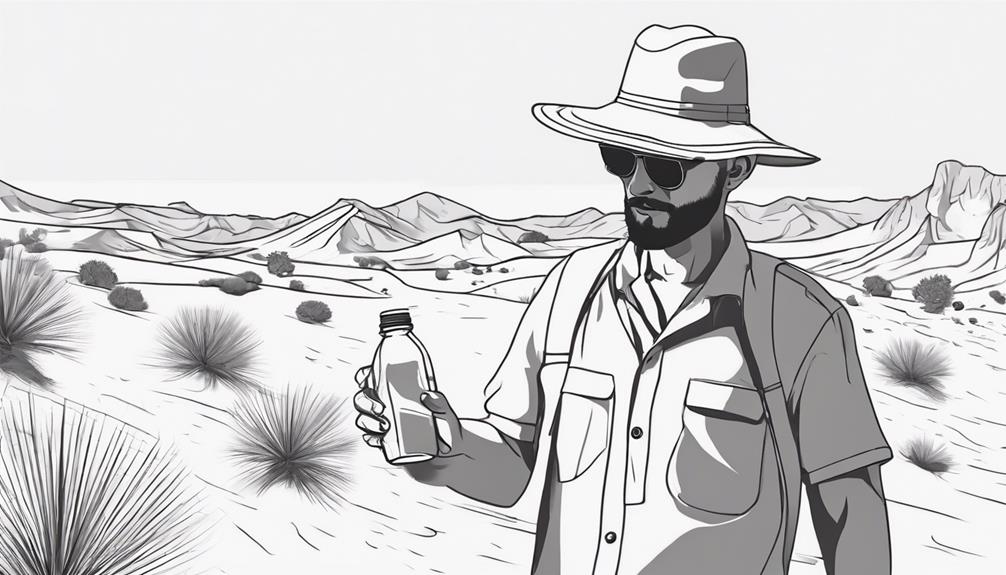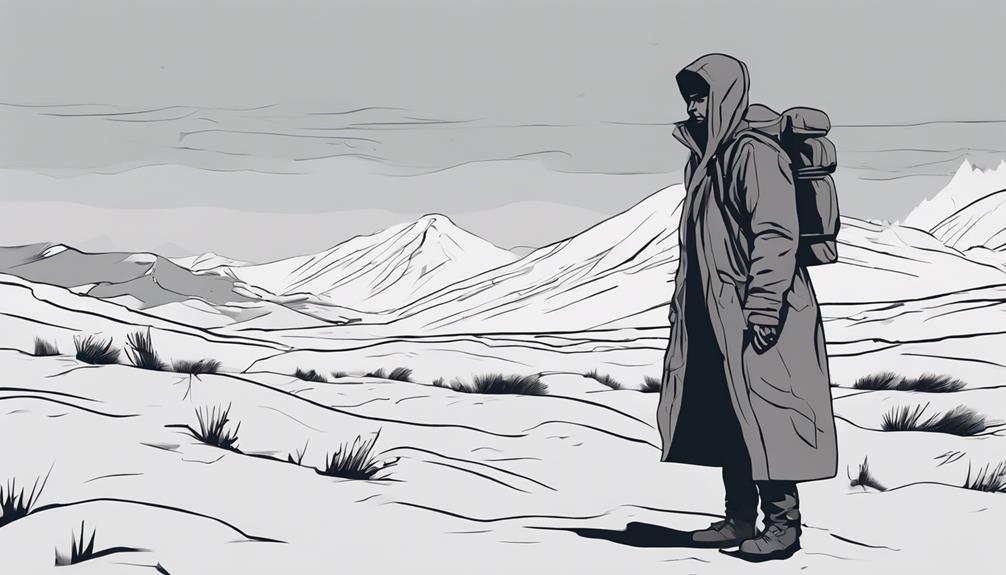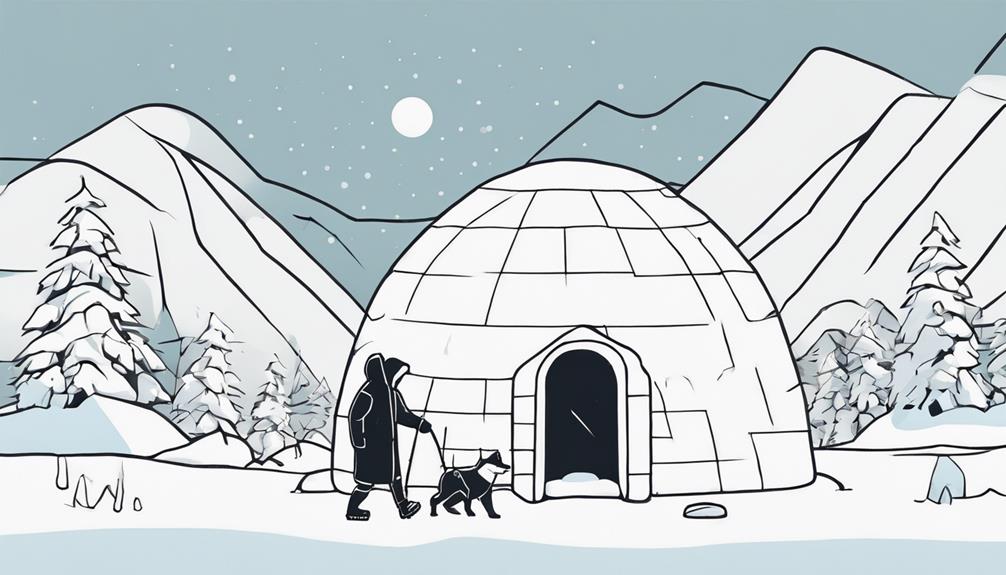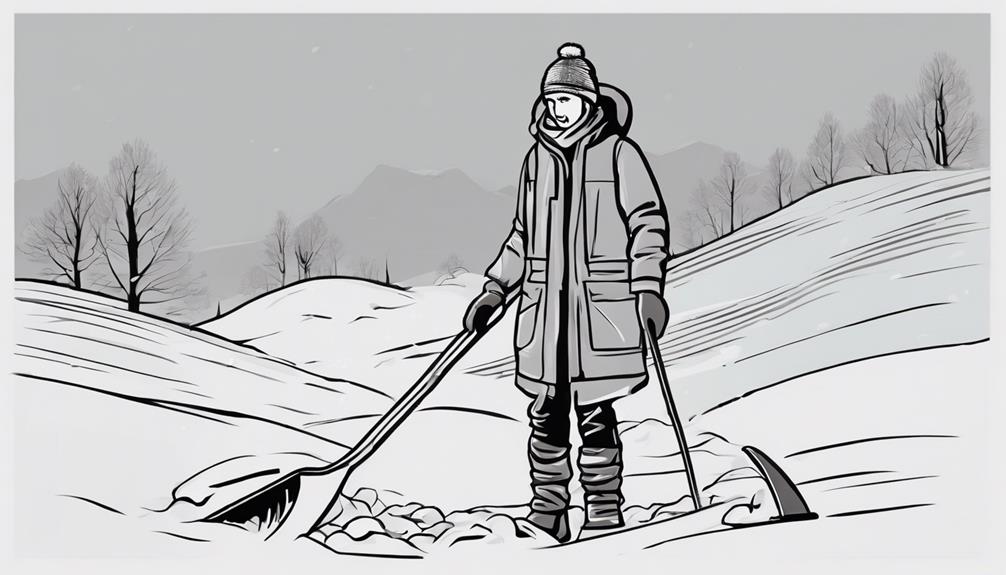Human survival in extreme environments presents a complex interplay of factors that challenge the limits of endurance and adaptation. From the icy expanses of the Arctic to the scorching heat of deserts, individuals employ a combination of biological, technological, and behavioral strategies to overcome inhospitable conditions. The quest to understand how humans navigate these harsh terrains unveils a fascinating tapestry of resilience and ingenuity, shedding light on the remarkable capabilities of the human body and mind when pushed to their limits. In exploring the intricacies of survival in extreme environments, we unravel not only the secrets of human adaptability but also the essence of our shared evolutionary journey.
Key Takeaways
- Utilize insulated shelters and traditional clothing for Arctic survival
- Employ water conservation techniques and efficient food sourcing in deserts
- Build shelters using natural materials for warmth retention in extreme environments
- Understand genetic adaptations and coping strategies for extreme temperatures
Arctic Survival Techniques

Arctic survival techniques encompass a range of methods and practices essential for thriving in the extreme cold and challenging conditions of the Arctic environment. Inhabitants of the Arctic, such as the Inuit and other Arctic populations, have adapted to the harsh climate through various strategies. One crucial technique is the construction of insulated shelters using snow blocks or ice blocks. These shelters provide much-needed protection from the extreme cold, wind, and snow prevalent in the region.
Moreover, Arctic populations, like the Inuit people, rely on traditional clothing made from caribou fur to stay warm in the harsh conditions. This clothing acts as an effective insulator, trapping body heat and providing essential warmth. Additionally, hunting and fishing are vital survival skills practiced in the Arctic. Inuit communities hunt seals and fish for food sources, ensuring their sustenance in the challenging environment.
Furthermore, teamwork and resource-sharing play a significant role in Arctic survival. In extreme cold, cooperation within Inuit communities becomes essential for collective survival, demonstrating the resilience and adaptability of Arctic populations to their environment.
Desert Survival Strategies
Desert survival strategies encompass a range of adaptations that enable organisms to thrive in arid environments. Water conservation techniques such as concentrating urine and deep root systems are crucial for desert plants and animals to minimize water loss. Shelter building methods and food foraging tips are also essential components of surviving in the harsh conditions of the desert.
Water Conservation Techniques
Organisms inhabiting arid environments have developed specialized mechanisms to conserve water, crucial for their survival in extreme conditions. Desert plants like cacti have adapted to store water in their tissues, enabling them to endure prolonged droughts. Similarly, desert animals such as kangaroo rats have evolved unique strategies to obtain water from their food sources and can concentrate urine to minimize water loss. Behavioral adaptations, like nocturnal activity to avoid the scorching heat, also play a significant role in water conservation among desert species. Efficient utilization of available water sources such as dew and succulent plants is paramount for desert organisms to thrive in these harsh environments, showcasing the remarkable adaptations that have evolved to combat water scarcity.
Shelter Building Methods
Given the imperative of water conservation in arid environments for survival, the strategic construction of shelters using natural materials becomes a critical component of desert survival strategies. Shelter building methods in arid deserts focus on creating shade and protection from extreme heat while stabilizing structures against wind using rocks and sandbags. These shelters are designed to retain warmth during cold desert nights, emphasizing proper ventilation and insulation for comfort and safety. Below is a table summarizing key points about shelter building methods in extreme environments:
| Shelter Building Methods | Description |
|---|---|
| Natural materials | Branches and leaves are used for construction |
| Shade and protection | Shelter focuses on protection from extreme heat |
| Stability against wind | Techniques like rocks and sandbags are used for stabilization |
| Retaining warmth | Shelters are designed to keep warmth during cold nights |
| Ventilation and insulation | Proper ventilation and insulation are crucial for comfort |
In extreme environments like arid deserts, these strategies are essential for survival.
Food Foraging Tips
In the challenging environment of arid deserts, effective food foraging techniques play a crucial role in ensuring survival by providing essential nutrients and sustenance. In desert survival, it is vital to prioritize water sources such as cacti, roots, and moisture-rich plants to maintain hydration levels. Edible insects, reptiles, and small mammals can serve as valuable sources of protein in these extreme environments. Regulating body temperature through shade and proper clothing is essential to minimizing water loss during extreme heat. To avoid consuming toxic plants and animals, it is crucial to learn how to identify safe food sources in the desert. Additionally, creating traps, snares, and foraging tools can significantly enhance food procurement and increase survival chances in desert conditions.
Coping With Extreme Cold
In coping with extreme cold, understanding the importance of layering for warmth, utilizing insulated shelter options, and benefiting from hot drinks are key strategies. Layering clothing helps trap heat close to the body, while insulated shelters provide crucial protection against the cold. Additionally, consuming hot drinks can help maintain core body temperature and provide a comforting respite from the cold environment.
Layering for Warmth
How can layering clothing effectively help individuals cope with extreme cold environments and maintain thermal comfort? In high-altitude and cold environments, layering is crucial for insulation. By wearing multiple layers, individuals create pockets of air between each garment, which act as an additional barrier to heat loss. Materials such as wool, fleece, and down are excellent insulators that trap heat close to the body. This layered approach also allows for flexibility in adjusting to fluctuating temperatures and activity levels. Additionally, moisture-wicking base layers help keep the skin dry, preventing heat loss from sweat. To protect extremities from frostbite, proper headgear, gloves, and footwear are essential when facing extreme cold conditions.
Insulated Shelter Options
Layering clothing effectively helps individuals cope with extreme cold environments by providing insulation, but insulated shelter options offer additional protection and comfort against harsh conditions. Insulated shelter options in high cold environments are crucial for survival. The table below highlights some effective insulated shelter options:
| Insulated Shelter Options | Description |
|---|---|
| Igloos | Made of compacted snow blocks, providing excellent thermal insulation. |
| Fur-lined Clothing | Parkas and boots made from animal hides offer additional insulation. |
| Heating Systems | Wood stoves or oil heaters help maintain a comfortable temperature inside. |
| Snow Caves | Dug into snow banks, providing natural insulation and wind protection. |
| Thermal Sleeping Bags | Essential for warmth and comfort during the night in extreme cold conditions. |
Hot Drink Benefits
Among the strategies individuals can employ to cope with extreme cold environments, the benefits of consuming hot drinks are paramount in maintaining core body temperature and overall well-being. Hot drinks like tea or soup offer the following advantages:
- Preventing Hypothermia: Hot drinks provide warmth and boost circulation, aiding in the prevention of hypothermia.
- Increased Energy Levels: The heat from hot beverages can elevate energy levels and help keep extremities warm in cold conditions.
- Enhanced Comfort: Drinking hot beverages can improve overall comfort and morale during exposure to extreme cold.
- Hydration and Nutrient Support: Hot drinks, such as herbal teas, not only offer warmth but also provide hydration and essential nutrients to support the body's functions in harsh cold climates.
Adapting to High Altitudes
Living at high altitudes presents a unique challenge for human populations, necessitating genetic adaptations for survival. Various populations like the Amhara, Quechua, Aymara, and Tibetans have developed specific genetic mutations in genes such as EPAS1 and EGLN1 to cope with the physiological stress induced by high altitudes. These genetic adaptations allow for enhanced responses to low oxygen levels by activating hypoxia-inducible factors, which regulate the body's oxygen-sensing mechanisms. By studying these genetic variations, scientists gain valuable insights into the intricate ways in which humans adapt to extreme environments like high altitudes.
Populations residing at high altitudes have evolved over time to withstand the reduced oxygen levels through complex genetic mechanisms that support their survival and well-being. These adaptations represent a remarkable example of how the human body can adjust to challenging conditions to thrive. Understanding the genetic underpinnings of high-altitude adaptations not only sheds light on human evolution but also highlights the resilience and adaptability of the human species in the face of physiological adversity.
Techniques for Surviving in Heat

In the realm of extreme environmental challenges, the focus now shifts to exploring effective techniques for surviving in high temperatures, where hydration, cooling strategies, appropriate clothing, and activity timing play pivotal roles in maintaining physiological equilibrium and preventing heat-related complications.
- Hydration: Crucial in heat survival as the body loses water through sweating.
- Cooling Strategies: Seek shade and use evaporative cooling techniques to regulate body temperature.
- Clothing Choice: Opt for light-colored, loose clothing to aid in heat dissipation and reduce heat absorption.
- Activity Timing: Avoid strenuous activity during peak heat hours to prevent heat-related illnesses.
Understanding the signs of heat exhaustion and heat stroke is vital for prompt intervention in extreme heat conditions. By implementing these strategies, individuals can better navigate and survive in extreme heat environments, safeguarding their health and well-being through a sound understanding of human physiology and the demands of extreme environments.
Navigating Polar Regions
Navigating Polar Regions requires a comprehensive understanding of the essential gear needed to withstand extreme cold conditions. Polar explorers must prioritize items like thermal clothing, snow goggles, and shelters to ensure protection from the harsh environment. Additionally, knowledge of traditional snow and ice conditions is crucial for safe travel in these challenging terrains.
Polar Gear Essentials
When venturing into polar regions, equipping oneself with specialized gear and essential equipment is paramount for survival in the extreme cold temperatures. Some polar gear essentials include:
- Insulated clothing to combat extreme cold temperatures.
- High-quality boots for protection and warmth.
- GPS devices for navigation in remote icy terrains.
- Emergency shelters to seek refuge during harsh weather conditions.
These items are crucial for staying safe and comfortable in the low temperatures of polar environments. Understanding the significance of proper gear and equipment can make a significant difference in the ability to navigate and survive in extreme cold conditions like those found in the Arctic and Antarctic.
Survival Shelter Options
Understanding the diverse options available for survival shelters in polar regions is crucial for enhancing readiness and resilience in extreme cold environments. In such harsh conditions, shelters like igloos utilize snow's insulating properties to maintain warmth inside, offering a protective refuge. Snow caves are effective at shielding individuals from harsh winds and low temperatures, providing safety in extreme cold. Quinzhees, constructed from snow mounds, offer thermal insulation and can be quickly built in emergencies. Portable shelters such as Arctic tents are designed to endure extreme weather and serve as temporary homes in polar regions. Mastery of building and utilizing these varied survival shelters is essential for successfully navigating and surviving in the extreme cold of polar environments.
Food and Water Strategies
To effectively endure the extreme cold and harsh conditions of polar regions, mastering strategic food and water consumption is paramount for survival.
- High-energy foods like fatty fish and meat are crucial to combat the cold.
- Limited access to fresh produce necessitates reliance on preserved and dried foods for sustenance.
- Melting ice and utilizing snow are common strategies for obtaining water in polar environments.
- Traditional methods of hunting and fishing provide essential nutrients for survival.
In extreme cold environments, it is essential to maintain high levels of energy through the consumption of specific foods and to ensure access to safe drinking water by utilizing innovative solutions like portable water purification systems.
Strategies for Desert Survival
Strategically seeking shade and conserving water are essential tactics for surviving in the harsh desert environment. In extreme desert conditions, exposure to direct sunlight can lead to heat stress and dehydration. Therefore, individuals must seek shade during the hottest parts of the day to reduce the risk of these dangers. Additionally, water conservation is crucial for desert survival. Limiting physical activity and minimizing sweating can help preserve precious water supplies in arid environments where water sources are scarce.
Constructing insulated shelters using natural materials can offer protection from the extreme temperature fluctuations that occur in deserts, helping individuals maintain a stable body temperature. Furthermore, foraging for edible desert plants and small animals can provide essential nutrients and sustenance for desert survival. It is also important to recognize the signs of dehydration and heat exhaustion to prevent health complications while navigating the challenges of extreme desert environments. By employing these strategies, individuals can enhance their chances of survival in the unforgiving desert landscape.
Surviving Harsh Climates

In harsh climates, the maintenance of body warmth through appropriate clothing and rest is essential for ensuring cognitive acuity and overall survival.
- Proper insulation with layered clothing helps retain body heat.
- Adequate rest prevents excessive energy expenditure, preserving warmth for vital functions.
- Consuming high-energy foods provides fuel for internal heat production.
- Using external heat sources like fires or shelters can supplement natural body warmth.
These strategies are crucial for individuals facing extreme environments where hypothermia poses a serious threat. Victims of accidental hypothermia have seen increased survival rates due to advancements in treatment methods like ECMO rewarming. Pharmacologic interventions play a vital role in supporting cardiovascular function during hypothermia, emphasizing the importance of timely and appropriate medical care in such scenarios. By implementing these measures, individuals can better withstand harsh climates and enhance their chances of survival.
Coping With Extreme Heat
Surviving extreme heat environments necessitates a comprehensive understanding of effective coping mechanisms and physiological responses to high temperatures. In extreme heat conditions, functional adaptation plays a crucial role in ensuring human survival. People in such environments rely on various strategies to prevent heat-related illnesses. Seeking shade, staying hydrated, and wearing light-colored, loose-fitting clothing are common practices to stay cool. Access to cooling centers, fans, or air conditioning can also help manage heat stress. Recognizing the signs of heat exhaustion and heat stroke is essential for timely intervention and survival. Proper acclimatization to extreme heat through gradual exposure, along with taking frequent breaks and resting in shaded areas, is key to coping with high temperatures. By employing these coping mechanisms and understanding the body's responses to extreme heat, individuals can increase their chances of surviving in harsh, hot environments.
Polar Region Survival Methods

Utilizing insulated clothing and traditional shelters such as igloos, individuals in polar regions employ strategic survival methods to combat extreme cold conditions. In these harsh environments, where temperatures plummet well below freezing, survival is dependent on adapting to the extreme cold and minimizing energy expenditure. Here are some key methods used by people to survive in the polar regions:
- Hunting and Fishing: Indigenous communities rely on hunting marine mammals like seals and fishing for fish to secure essential food sources in the extreme cold.
- Traditional Knowledge: Drawing upon generations of traditional knowledge and skills, people in the Arctic adapt to the harsh polar conditions effectively.
- Resource Utilization: Efficient use of available resources such as blubber, which serves as both fuel and nutrition, is crucial for survival in the polar regions.
- Transportation: The use of sled dogs and snowmobiles enables individuals to navigate the vast and icy terrain, reducing energy expenditure and increasing chances of survival in these extreme cold environments.
Desert Environment Survival
Organisms inhabiting desert environments have developed remarkable adaptations to survive in arid conditions, including strategies for conserving water and tolerating extreme heat. Through the process of natural selection, desert plants and animals have evolved mechanisms to thrive in these harsh environments. For instance, many desert species exhibit nocturnal activity to avoid the scorching sun during the day, reducing water loss through transpiration. Additionally, plants like cacti have adapted to store water in their tissues to sustain themselves through long periods of drought.
Furthermore, desert animals such as camels have unique physiological features like specialized kidneys that concentrate urine to conserve water. Camels also rely on their humps to store fat, providing an energy reserve rather than water storage. Insects in deserts have developed hydrophobic exoskeletons to prevent water loss through evaporation. These adaptations showcase the incredible resilience of desert organisms in the face of extreme environmental challenges.
Extreme Cold Weather Tactics

In extreme cold weather conditions, individuals employ various tactics to safeguard themselves against the chilling temperatures and potential risks to their health and well-being.
- Layering Clothing: People wear multiple layers of clothing to trap heat and insulate their bodies effectively.
- Specialized Gear: Utilizing thermal jackets, gloves, and boots helps protect against frostbite and hypothermia by providing additional warmth and protection.
- Nutrition and Hydration: Consuming high-calorie foods and staying hydrated are crucial to maintaining body heat and energy levels in extreme cold environments.
- Building Shelters: Constructing shelters with proper insulation, such as snow caves or igloos, offers protection from harsh cold conditions and helps retain heat within the sheltered area.
Frequently Asked Questions
Can Humans Survive in Extreme Environments?
Humans can survive in extreme environments through a combination of adaptation strategies and physiological responses. By utilizing mechanisms such as thermoregulation and acclimatization, individuals can maintain body temperature, conserve energy, and secure essential resources. Research into genetic and physiological adaptations provides valuable insights into human capabilities in harsh conditions. Training, appropriate equipment, and knowledge are key factors that enable individuals to not only survive but also thrive in extreme environments.
What Can Survive in Extreme Environments?
In the realm of extreme environments, a fascinating array of life showcases remarkable resilience through extreme adaptations and survival strategies. Biodiversity in such harsh settings reveals a spectrum of organisms, from extremophiles thriving in volcanic vents to tardigrades enduring high radiation. These resilient beings exemplify the marvels of nature's ingenuity in confronting adversity and thriving where few others can. Their existence underscores the intricate tapestry of life's adaptability and the enduring power of evolutionary mechanisms.
What Is the Ability to Live in Extreme Environments?
The ability to live in extreme environments is underpinned by a complex interplay of adaptation strategies and physiological changes. Organisms in such conditions exhibit specialized mechanisms to maintain internal stability, or homeostasis, in the face of external challenges. These adaptations can include alterations in metabolism, thermal regulation, and hydration levels to ensure survival. Understanding these intricate physiological adjustments is crucial for comprehending how living organisms thrive in extreme environments.
Why Do People Live in Extreme Environments?
People live in extreme environments for numerous reasons beyond survival needs. Adaptation strategies and cultural practices play pivotal roles in their decision-making. These environments often hold historical significance or provide unique opportunities for specific occupations. Understanding why individuals choose to inhabit such harsh conditions offers insights into human resilience and innovation. By studying these communities, we unravel the complexities of human adaptation and the diverse motivations that drive people to thrive in extreme settings.
Conclusion
In conclusion, human survival in extreme environments relies on a combination of technological innovations, biological adaptations, and behavioral strategies. One interesting statistic is that the Inuit people, who have lived in the Arctic for thousands of years, have genetic adaptations that allow them to efficiently metabolize high-fat diets and withstand extreme cold temperatures. Understanding these mechanisms is crucial for studying human survival in challenging environments and advancing our knowledge of human genetics and physiology.
